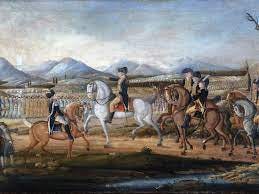Mutual Provocations and Simultaneous Escalations: Two Examples from Early U.S. History
It may be critical to face up to real goals.
For my forthcoming book, The Hamilton Scheme: An Epic Tale of Money and Power in Founding America, I’ve recently been revisiting—I swear it’s for the last time!—two major events of the early U.S. republic, in which, while I don’t think they offer anything like parallels to anything going on now, the Washington administration and its opponents took what I think are interesting and resonant approaches to both diplomacy and military action. Neither puts Washington and his cabinet in a flattering light, but in both, the administration showed resolve and cunning and achieved its goals, which in both cases weren’t the publicly stated goals. Also, both events came to a climax in 1794, at more or less the same time.
One, which I’ll present today, involved a rapidly developing national crisis that I see as born of mutual provocation via a series of deliberate, near-simultaneous escalations on both sides: a race, in a sense, to see who could be first to light the fuse and set off a military confrontation. The contestants were the Washington administration and a secessionist shadow government largely in control, by 1793, of the five counties of western Pennsylvania, with ties to neighboring western counties of Virginia and Maryland, as well as elements in what had recently become the Kentucky region of the Southwest Territory of the United States. I won’t review here the events of what became known dismissively as the Whiskey Rebellion (you can follow “Further Reading” links below); suffice it to say that the national crisis was real.
Ordinary people of western Pennsylvania had reason to see the federal government as escalating oppression instead of trying to resolve conflict. Hence, to their leadership, the seeming necessity of organizing a region-wide secessionist response going well beyond protest. The federal tax they objected to was intended, in itself, as an act of aggression against them, as a selected target, a fact routinely overlooked in biographies of the tax’s author, Alexander Hamilton, as well as by some scholars, though it’s well supported by the most thoroughgoing scholarship (noted below) and perfectly consistent with Hamilton’s well-known goals for the country’s economy. I won’t try to prove that point here. A detailed argument underlies that part of the much broader epic drama in my forthcoming Hamilton Scheme.
Hamiltonians prefer to ignore two key things: 1) the tax was intricately structured to benefit big commercial distillers and drive out of business the small, artisanal producers, especially in what was then the West, who depended on whiskey as their one lifeline to cash; 2) the tax’s proceeds, drawn disproportionately from a large, unrich group, were earmarked for making interest payments—tax free—to a small group of rich holders of federal war bonds. Hamilton was convinced that this was the best thing for the growth of the United States, but you can see why paying such a tax would piss people off.



